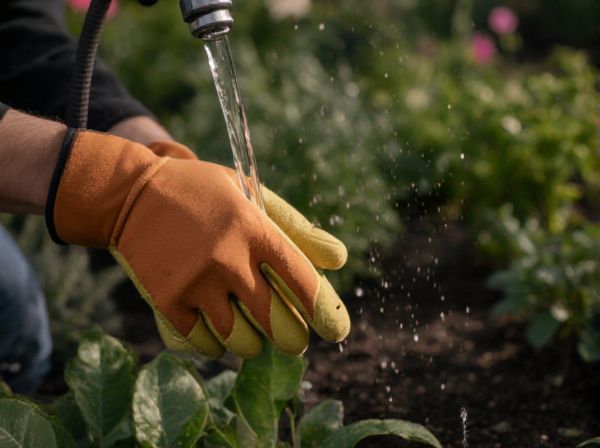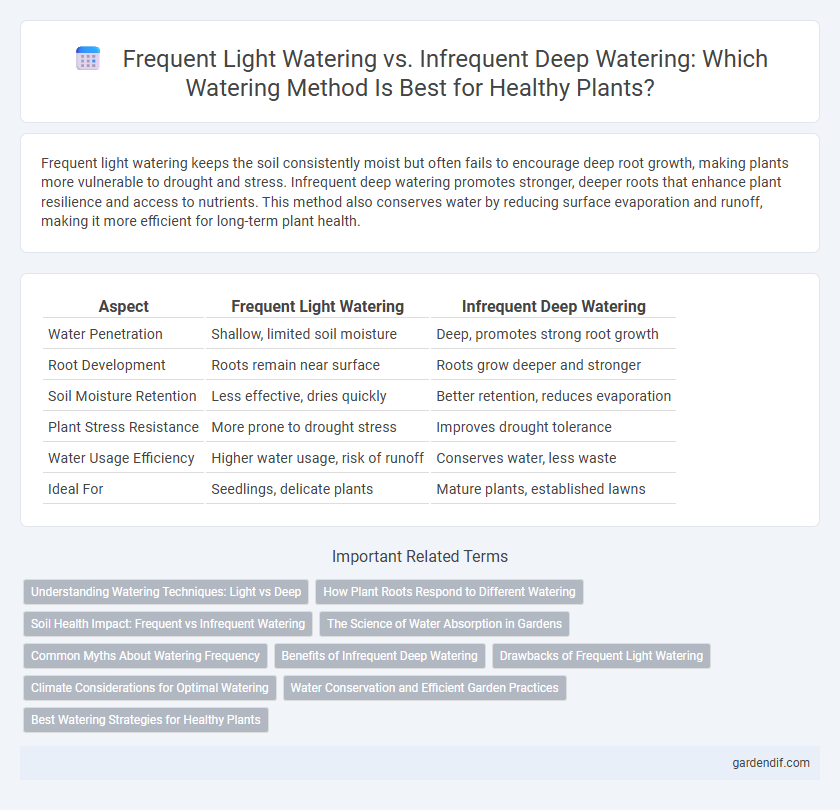
Frequent light watering vs Infrequent deep watering Illustration
Frequent light watering keeps the soil consistently moist but often fails to encourage deep root growth, making plants more vulnerable to drought and stress. Infrequent deep watering promotes stronger, deeper roots that enhance plant resilience and access to nutrients. This method also conserves water by reducing surface evaporation and runoff, making it more efficient for long-term plant health.
Table of Comparison
| Aspect | Frequent Light Watering | Infrequent Deep Watering |
|---|---|---|
| Water Penetration | Shallow, limited soil moisture | Deep, promotes strong root growth |
| Root Development | Roots remain near surface | Roots grow deeper and stronger |
| Soil Moisture Retention | Less effective, dries quickly | Better retention, reduces evaporation |
| Plant Stress Resistance | More prone to drought stress | Improves drought tolerance |
| Water Usage Efficiency | Higher water usage, risk of runoff | Conserves water, less waste |
| Ideal For | Seedlings, delicate plants | Mature plants, established lawns |
Understanding Watering Techniques: Light vs Deep
Frequent light watering keeps the soil surface moist but often fails to reach deeper roots, leading to shallow root development and increased vulnerability to drought. Infrequent deep watering promotes deep root growth by thoroughly saturating the soil, enhancing plant resilience and water uptake efficiency. Understanding these watering techniques ensures optimal moisture levels for healthy plant growth and sustainable water use.
How Plant Roots Respond to Different Watering
Frequent light watering encourages roots to remain near the soil surface, resulting in shallow root systems vulnerable to drought stress and nutrient deficiencies. Infrequent deep watering promotes deeper root growth, enhancing plants' ability to access moisture and nutrients from lower soil layers. Root depth and distribution significantly affect plant resilience, drought tolerance, and overall health depending on watering patterns.
Soil Health Impact: Frequent vs Infrequent Watering
Frequent light watering often leads to shallow root growth as moisture only penetrates the surface, increasing soil erosion and nutrient leaching. Infrequent deep watering encourages roots to grow deeper, improving soil aeration and enhancing beneficial microbial activity crucial for soil health. Maintaining balanced soil moisture through deep watering practices supports robust plant development and long-term soil structure stability.
The Science of Water Absorption in Gardens
Frequent light watering primarily moistens the soil surface, leading to shallow root growth and increased evaporation, limiting effective water absorption in garden plants. Infrequent deep watering promotes deeper root penetration and enhances soil water retention by encouraging roots to access moisture stored deeper in the soil profile. This deep moisture absorption supports plant resilience during dry periods and improves overall garden health by optimizing water use efficiency.
Common Myths About Watering Frequency
Frequent light watering is often believed to keep plants consistently hydrated, but it can lead to shallow root systems and increased susceptibility to drought stress, while infrequent deep watering encourages robust root growth and better water absorption. Common myths suggest daily watering is necessary, yet many plants thrive with watering intervals that allow the soil to dry partially, promoting deeper rooting. Scientific studies highlight that adjusting watering frequency based on plant type, soil composition, and climate significantly improves water efficiency and plant health.
Benefits of Infrequent Deep Watering
Infrequent deep watering promotes stronger root growth by encouraging roots to penetrate deeper into the soil, enhancing drought resistance and nutrient uptake. This method reduces surface evaporation, conserving water and improving overall irrigation efficiency. Deep watering supports healthier plants with increased resilience against pests and stress compared to frequent light watering.
Drawbacks of Frequent Light Watering
Frequent light watering can lead to shallow root development, making plants more vulnerable to drought and stress. This method often results in inefficient water use due to increased evaporation and runoff. Over time, shallow roots reduce the plant's ability to absorb nutrients and withstand environmental fluctuations.
Climate Considerations for Optimal Watering
Frequent light watering suits humid climates where evaporation is low, maintaining surface moisture for delicate plants. Infrequent deep watering benefits arid or hot regions by encouraging deep root growth, improving drought resistance. Adjust watering schedules based on local temperature, humidity, and soil type to optimize plant health and water efficiency.
Water Conservation and Efficient Garden Practices
Frequent light watering leads to water runoff and shallow root growth, reducing overall water efficiency in garden practices. Infrequent deep watering encourages roots to grow deeper, improving drought resistance and optimizing water conservation. Efficient garden management incorporates deep watering schedules to minimize water waste and enhance plant health.
Best Watering Strategies for Healthy Plants
Frequent light watering often leads to shallow root growth, making plants more susceptible to drought and stress. Infrequent deep watering encourages roots to grow deeper into the soil, enhancing drought tolerance and nutrient uptake. Optimal watering strategies prioritize deep, thorough irrigation sessions to promote robust root systems and sustainable plant health.
Frequent light watering vs Infrequent deep watering Infographic

 gardendif.com
gardendif.com